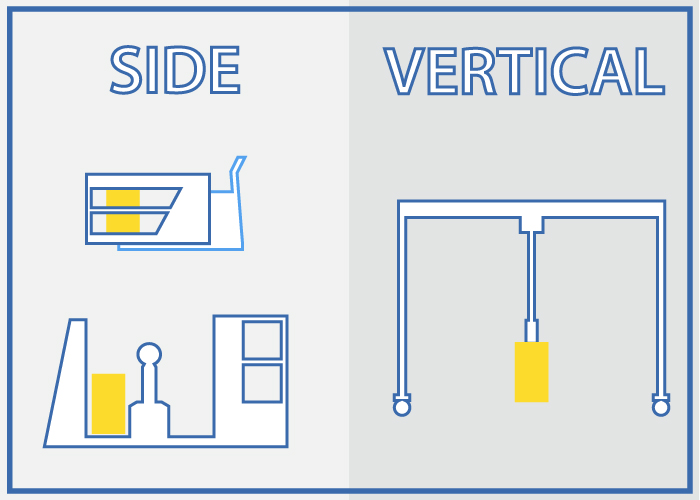We use cookies to make your experience better. To comply with the new e-Privacy directive, we need to ask for your consent to set the cookies. Learn more.
The Three Basic Types Of Forklift Battery Handling Equipment and Their Benefits
When it comes to changing out forklift batteries, OSHA regulations have a lot to say. But of all the federal safety standards that cover the battery room, two stand out as the most vital. First, changing and charging forklift batteries should be done in a designated area of your facility. Second, forklift batteries should be changed using appropriate forklift battery handling equipment.
You can divide forklift battery handling equipment into three basic categories, each configured for different lift truck designs and operational challenges. Depending on these factors, one of the following technologies will provide the safest, most efficient battery changes available.

Some forklifts are designed for battery removal from the side, which can be accomplished with a Battery Carriage or Operator Aboard Battery Extractor. Forklifts requiring vertical extraction need a Portable Gantry Crane for the task.
Portable Gantry Crane Systems
A gantry crane is the classic machine for handling forklift batteries. Before side-extraction designs took over the forklift market, batteries had to be lifted out of compartments vertically — and there are plenty of trucks in operation that still require vertical extraction. Gantry cranes accomplish this task quickly and safely, and are available in a variety of manual and powered configurations. Powered gantries offer more safety and efficiency benefits because they reduce operator fatigue and the chance of injury to personnel and equipment.
BHS offers both powered and non-powered gantries in a variety of beam spans and capacities to fit your warehouse's needs. BHS gantry cranes provide safe and easy vertical extraction for most standard lift truck batteries.
Battery Carriage Systems
Not all forklifts are built for vertical battery extraction. In fact, these days, most aren’t. Lateral battery changes require dedicated equipment such as Battery Carriages.
At the very least, every owner of an electric forklift needs manual equipment to safely remove and replace forklift batteries. Walkie Transfer Carriages (WTC) allow users to change batteries in side-extraction applications safely and quickly — but for really fast battery changes, you’ll need some electric power. That's why higher-output warehouses turn to more automatic means of handling forklift batteries.
Battery Transfer Carriages (BTC) from BHS are available with every possible combination of powered functionality, from a manual travel with winch-powered extraction to fully powered lift and extraction actions.
BHS' Automatic Transfer Carriages mount on pallet trucks, which allows a warehouse to cut equipment costs by using existing equipment. Their hydraulic-powered push-pull extraction cuts down on the time it takes to change out forklift batteries manually and provides OSHA-compliant safety benefits.
For even larger fleets, Mobile Battery Extractors can travel anywhere in the facility to change batteries truck-side. Their hydraulic-powered extractor arms effortlessly handle up to 5,000 pounds of steel, lead, and electrolyte, and they’re designed for a minimum of maintenance.
Powered transfer carriages reduce the time it takes to change out forklift batteries. They make a shipping and receiving operation more efficient. For larger and busier operations, at least some degree of automation is a must in order to keep up with the competition.
Operator Aboard Battery Extractors
For large and busy warehouses that frequently change dozens of batteries per day, Operator Aboard Battery Extractors (BE) provide the quickest and safest means to seamlessly change out batteries, reducing downtime for every truck in the fleet.
Larger-scale warehouses will naturally have busier battery changing areas. Many battery rooms take advantage of vertical space by using multi-tier forklift battery charging stands, up to four levels high. For the sake of efficiency and safety, a systematic and comprehensive approach to battery change-outs is particularly important for these high-volume battery rooms, and Operator Aboard Battery Extractors provide the solution.
Operator Aboard Battery Extractors substantially reduce the time that it takes to change out a forklift battery. Additionally, there are applications that can track each battery on the shelves and in the forklifts to instantly inform forklift operators which battery to choose during change-outs. Such applications make it exponentially easier to maximize the health and efficiency of a forklift fleet.
Operations of all sizes benefit from BHS' operator aboard battery extractors, which are available in models ranging from single-level to quad-stack.
No matter the size of your forklift fleet, you’ll need one of these three types of forklift battery handling equipment in order to comply with OSHA regulations. Some trucks require gantry cranes, while others can only be served by Battery Extractors. But either way, the heavy duty steel construction of BHS battery handling equipment will get your forklifts back out onto the floor as quickly and safely possible, boosting efficiency overall.
References
“Powered industrial trucks - 1910.178.” OSHA. Occupational Safety & Health Administration,
United States Department of Labor, n.d. Web. 11 Apr. 2016.
“Powered Industrial Trucks (Forklift).” OSHA. Occupational Safety & Health Administration,
United States Department of Labor, n.d. Web. 11 Apr. 2016
